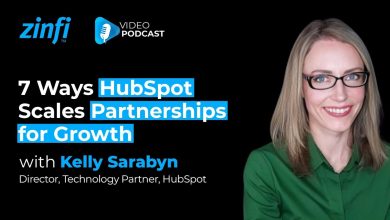Ecosystem-as-a-Service Models: The Future of Collaborative Business
Exploring the concept of EaaS, its key components, benefits, challenges, and its transformative potential in the context of Partner Go-To-Market (GTM) strategies.
 Ecosystem-as-a-Service (EaaS) models represent an emerging paradigm in business strategy, where companies orchestrate and manage interconnected networks of partners, technologies, and services to deliver seamless, value-driven solutions to customers.
Ecosystem-as-a-Service (EaaS) models represent an emerging paradigm in business strategy, where companies orchestrate and manage interconnected networks of partners, technologies, and services to deliver seamless, value-driven solutions to customers.
Rather than building every component of a solution in-house, businesses leverage EaaS to integrate external partners—such as technology providers, resellers, developers, or service providers—into a cohesive ecosystem that operates as a unified platform.
This model enables rapid scalability, innovation, and customer-centricity by combining the strengths of multiple stakeholders.
Defining Ecosystem-as-a-Service
EaaS is a business model where a central organization, often referred to as the orchestrator, curates and manages a network of partners to deliver integrated solutions as a service. Unlike traditional partnerships that focus on bilateral relationships, EaaS creates a dynamic, interconnected ecosystem where participants collaborate to provide end-to-end value.
For example, a cloud provider like AWS or Microsoft Azure operates an EaaS model by offering a platform where independent software vendors, system integrators, and customers can co-create, deploy, and consume solutions. The orchestrator provides the infrastructure, tools, and governance, while partners contribute specialized capabilities, such as applications, integrations, or consulting services.
The essence of EaaS lies in its ability to streamline collaboration and deliver holistic customer experiences. By centralizing resources like APIs, marketplaces, or partner management tools, EaaS enables participants to focus on their core competencies while benefiting from the collective strength of the ecosystem. This model is particularly prevalent in industries like technology, healthcare, and financial services, where complex customer needs require integrated, multi-vendor solutions.
Why Ecosystem-as-a-Service Is Gaining Traction
Several factors are driving the adoption of EaaS models. First, customers increasingly demand seamless, end-to-end solutions that combine products, services, and support. EaaS enables businesses to meet these expectations by integrating diverse offerings into a single, cohesive experience. Second, the rapid pace of digital transformation has made it impractical for companies to build every capability in-house.
EaaS allows organizations to tap into external expertise and innovation, accelerating time-to-market. Third, the rise of platform-based business models, powered by cloud computing and APIs, has created fertile ground for EaaS, enabling scalable, plug-and-play ecosystems.
Finally, EaaS supports cost efficiency by allowing companies to share development, marketing, and operational costs with partners, reducing the financial burden of market expansion.
Featured Vendor: Partner Fleet
The #1 way to power your ecosystem business model. Partner Fleet enables you to build an app marketplace that promotes your partnerships to capture new business, create stickier customers, and increase win rates.
Key Components of Ecosystem-as-a-Service
A successful EaaS model requires careful orchestration and several critical elements. The first is a robust platform infrastructure, such as a cloud-based marketplace or API hub, that enables seamless integration and collaboration among partners. This infrastructure must be scalable, secure, and easy to use.
The second component is a clear governance framework, which defines roles, responsibilities, and revenue-sharing models to ensure alignment and transparency. Third, EaaS relies on partner enablement, providing tools, training, and resources to help partners contribute effectively to the ecosystem.
Finally, a strong focus on customer outcomes is essential, ensuring that the ecosystem delivers measurable value, such as faster deployment, cost savings, or enhanced functionality.
Benefits of Ecosystem-as-a-Service
EaaS offers significant advantages for businesses and their partners. It accelerates innovation by enabling rapid integration of new technologies and services, allowing companies to stay ahead of market trends. It also expands market reach, as partners bring access to new customer segments, geographies, or industries.
For customers, EaaS delivers seamless, integrated solutions that address complex needs, improving satisfaction and loyalty. Additionally, EaaS enhances scalability, allowing businesses to grow without the need for significant upfront investments in infrastructure or talent. By sharing risks and resources, EaaS also reduces costs and fosters resilience in volatile markets.
Challenges and Mitigation Strategies
Despite its potential, EaaS comes with challenges. Coordinating a diverse network of partners can be complex, requiring robust governance and communication to prevent conflicts or misalignments. Ensuring data security and compliance across the ecosystem is another hurdle, particularly in regulated industries like healthcare or finance. Additionally, smaller partners may lack the resources to fully participate, necessitating robust enablement programs. To address these challenges, orchestrators should invest in centralized partner management platforms, establish clear contractual agreements, and prioritize transparency in revenue sharing and performance tracking.
EaaS in Partner GTM Strategies
In the context of Partner GTM, EaaS serves as a powerful enabler. It allows companies to scale their go-to-market efforts by leveraging the collective capabilities of ecosystem partners. For example, a SaaS provider might use an EaaS model to integrate complementary apps, services, and consulting expertise into its platform, creating a comprehensive solution that drives customer adoption and revenue.
By embedding partners into a unified ecosystem, businesses can streamline co-marketing, co-selling, and service delivery, turning relationships into a revenue channel. EaaS also supports agility, enabling companies to quickly adapt to changing market demands by onboarding new partners or solutions.
The Future of Ecosystem-as-a-Service
As technology evolves, EaaS models are poised to become even more impactful. Advances in AI and machine learning will enable smarter partner matching and predictive analytics, optimizing ecosystem performance. Blockchain technology could enhance transparency in revenue sharing and contract enforcement, fostering trust among participants.
Additionally, the growing emphasis on sustainability and social impact will drive EaaS models that prioritize purpose-driven partnerships, aligning ecosystems with shared values. As businesses increasingly adopt platform-based strategies, EaaS will become a cornerstone of collaborative growth, enabling organizations to deliver innovative, customer-centric solutions at scale.
Conclusion
Ecosystem-as-a-Service models represent a transformative approach to building and scaling business ecosystems. By orchestrating interconnected networks of partners, EaaS enables companies to deliver integrated, customer-focused solutions while driving innovation and revenue growth.
Despite challenges like coordination and security, the benefits of scalability, market reach, and cost efficiency make EaaS a compelling strategy for modern businesses. In the context of Partner GTM, EaaS amplifies the power of partnerships, turning relationships into a dynamic revenue engine.
As technology and customer expectations continue to evolve, EaaS will play a pivotal role in shaping the future of collaborative business, enabling organizations to thrive in an increasingly interconnected world.



